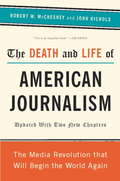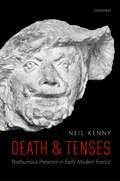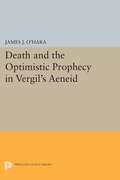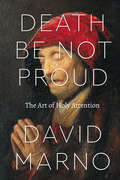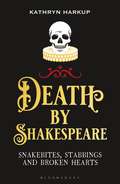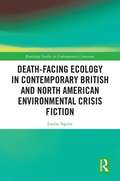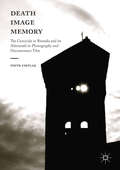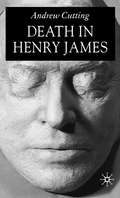- Table View
- List View
The Death and Life of American Journalism: The Media Revolution That Will Begin the World Again
by Robert W. McChesney John NicholsDaily newspapers are closing across America. Washington bureaus are shuttering; whole areas of the federal government are now operating with no press coverage. International bureaus are going, going, gone. Journalism, the counterbalance to corporate and political power, the lifeblood of American democracy, is not just threatened. It is in meltdown. In The Death and Life of American Journalism, Robert W. McChesney, an academic, and John Nichols, a journalist, who together founded the nation's leading media reform network, Free Press, investigate the crisis. They propose a bold strategy for saving journalism and saving democracy, one that looks back to how the Founding Fathers ensured free press protection with the First Amendment and provided subsidies to the burgeoning print press of the young nation.
Death and Tenses: Posthumous Presence in Early Modern France
by Neil KennyIn what tense should we refer to the dead? The question has long been asked, from Cicero to Julian Barnes. Answering it is partly a matter of grammar and stylistic convention. But the hesitation, annoyance, and even distress that can be caused by the "wrong" tense suggests that more may be at stake—our very relation to the dead. This book, the first to test that hypothesis, investigates how tenses were used in sixteenth and early seventeenth-century France (especially in French but also in Latin) to refer to dead friends, lovers, family members, enemies, colleagues, writers, officials, kings and queens of recent times, and also to those who had died long before, whether Christ, the saints, or the ancient Greeks and Romans who posthumously filled the minds of Renaissance humanists. Did tenses refer to the dead in ways that contributed to granting them differing degrees of presence (and absence)? Did tenses communicate dimensions of posthumous presence (and absence) that partly eluded more concept-based affirmations? The investigation ranges from funerary and devotional writing to Eucharistic theology, from poetry to humanist paratexts, from Rabelais's prose fiction to Montaigne's Essais. Primarily a work of literary and cultural history, it also draws on early modern grammatical thought and on modern linguistics (with its concept of aspect and its questioning of "tense"), while arguing that neither can fully explain the phenomena studied. The book briefly compares early modern usage with tendencies in modern French and English in the West, asking whether changes in belief about posthumous survival have been accompanied by changes in tense-use.
Death and the Early Modern Englishwoman
by Lucinda M. BeckerThis study explores the female experience of death in early modern England. By tracing attitudes towards gender through the occasion of death, it advances our understanding of the construction of femininity in the period. Becker illustrates how dying could be a positive event for a woman, and for her mourners, in terms of how it allowed her to be defined, enabled and elevated. The first part of the book gives a cultural and historical overview of death in early modern England, examining the means by which human mortality was confronted, and how the fear of death and dying could be used to uphold the mores of society. Becker explores particularly the female experience of death, and how women used the deathbed as a place of power from which to bestow dying maternal blessings, or leave instructions and advice for their survivors. The second part of the study looks at 'good' and 'bad' female deaths. The author discusses the motivation behind the reporting of the deaths and the veracity of such accounts, and highlights the ways in which they could be used for religious, political and patriarchal purposes. The third section of the book considers how death could, paradoxically, liberate a woman. In this section Becker evaluates the opportunity for female involvement in dying and posthumous rituals, including funeral rites and sermons, commemorative and autobiographical writing and literary legacies. While accounts of dying women largely underpinned the existing patriarchy, the experience of dying allowed some women to express themselves by allowing them to utilise an established male discourse. This opportunity for expression, along with the power of the deathbed, are the focus for this study.
Death and the Early Modern Englishwoman
by Lucinda M. BeckerThis study explores the female experience of death in early modern England. By tracing attitudes towards gender through the occasion of death, it advances our understanding of the construction of femininity in the period. Becker illustrates how dying could be a positive event for a woman, and for her mourners, in terms of how it allowed her to be defined, enabled and elevated. The first part of the book gives a cultural and historical overview of death in early modern England, examining the means by which human mortality was confronted, and how the fear of death and dying could be used to uphold the mores of society. Becker explores particularly the female experience of death, and how women used the deathbed as a place of power from which to bestow dying maternal blessings, or leave instructions and advice for their survivors. The second part of the study looks at 'good' and 'bad' female deaths. The author discusses the motivation behind the reporting of the deaths and the veracity of such accounts, and highlights the ways in which they could be used for religious, political and patriarchal purposes. The third section of the book considers how death could, paradoxically, liberate a woman. In this section Becker evaluates the opportunity for female involvement in dying and posthumous rituals, including funeral rites and sermons, commemorative and autobiographical writing and literary legacies. While accounts of dying women largely underpinned the existing patriarchy, the experience of dying allowed some women to express themselves by allowing them to utilise an established male discourse. This opportunity for expression, along with the power of the deathbed, are the focus for this study.
Death and the Labyrinth
by Michel Foucault James Faubion Charles RuasDeath and the Labyrinth is unique, being Foucault's only work on literature. For Foucault this was "by far the book I wrote most easily and with the greatest pleasure". Here, Foucault explores theory, criticism and psychology through the texts of Raymond Roussel, one of the fathers of experimental writing, whose work has been celebrated by the likes of Cocteau, Duchamp, Breton, Robbe Grillet, Gide and Giacometti.This revised edition includes an introduction, chronology and bibliography to Foucault's work by James Faubion, an interview with Foucault, conducted only nine months before his death, and concludes with an essay on Roussel by the poet John Ashbery.
Death and the Optimistic Prophecy in Vergil's AENEID (PDF)
by James J. O'HaraHere James O'Hara shows how the deceptive nature of prophecy in the Aeneid complicates assessment of the poem's attitude toward its hero's achievement and toward the future of Rome under Augustus Caesar. This close study of the language and rhetorical context of the prophecies reveals that they regularly suppress discouraging material: the gods send promising messages to Aeneas and others to spur them on in their struggles, but these struggles often lead to untimely deaths or other disasters only darkly hinted at by the prophecies. O'Hara finds in these prophecies a persistent subtext that both stresses the human cost of Aeneas' mission and casts doubt on Jupiter's promise to Venus of an "endless empire" for the Romans. O'Hara considers the major prophecies that look confidently toward Augustus' Rome from the standpoint of Vergil's readers, who, like the characters within the poem, must struggle with the possibility that the optimism of the prophecies of Rome is undercut by darker material partially suppressed. The study shows that Vergil links the deception of his characters to the deceptiveness of Roman oratory, politics, and religion, and to the artifice of poetry itself. In response to recent debates about whether the Aeneid is optimistic or pessimistic, O'Hara argues that Vergil expresses both the Romans' hope for the peace of a Golden Age under Augustus and their fear that this hope might be illusory.Originally published in 1990.The Princeton Legacy Library uses the latest print-on-demand technology to again make available previously out-of-print books from the distinguished backlist of Princeton University Press. These editions preserve the original texts of these important books while presenting them in durable paperback and hardcover editions. The goal of the Princeton Legacy Library is to vastly increase access to the rich scholarly heritage found in the thousands of books published by Princeton University Press since its founding in 1905.
Death Be Not Proud: The Art of Holy Attention (Class 200: New Studies in Religion)
by David MarnoThe seventeenth-century French philosopher Nicolas Malebranche thought that philosophy could learn a valuable lesson from prayer, which teaches us how to attend, wait, and be open for what might happen next. Death Be Not Proud explores the precedents of Malebranche’s advice by reading John Donne’s poetic prayers in the context of what David Marno calls the “art of holy attention.” If, in Malebranche’s view, attention is a hidden bond between religion and philosophy, devotional poetry is the area where this bond becomes visible. Marno shows that in works like “Death be not proud,” Donne’s most triumphant poem about the resurrection, the goal is to allow the poem’s speaker to experience a given doctrine as his own thought, as an idea occurring to him. But while the thought must feel like an unexpected event for the speaker, the poem itself is a careful preparation for it. And the key to this preparation is attention, the only state in which the speaker can perceive the doctrine as a cognitive gift. Along the way, Marno illuminates why attention is required in Christian devotion in the first place and uncovers a tradition of battling distraction that spans from ascetic thinkers and Church Fathers to Catholic spiritual exercises and Protestant prayer manuals.
Death Be Not Proud: The Art of Holy Attention (Class 200: New Studies in Religion)
by David MarnoThe seventeenth-century French philosopher Nicolas Malebranche thought that philosophy could learn a valuable lesson from prayer, which teaches us how to attend, wait, and be open for what might happen next. Death Be Not Proud explores the precedents of Malebranche’s advice by reading John Donne’s poetic prayers in the context of what David Marno calls the “art of holy attention.” If, in Malebranche’s view, attention is a hidden bond between religion and philosophy, devotional poetry is the area where this bond becomes visible. Marno shows that in works like “Death be not proud,” Donne’s most triumphant poem about the resurrection, the goal is to allow the poem’s speaker to experience a given doctrine as his own thought, as an idea occurring to him. But while the thought must feel like an unexpected event for the speaker, the poem itself is a careful preparation for it. And the key to this preparation is attention, the only state in which the speaker can perceive the doctrine as a cognitive gift. Along the way, Marno illuminates why attention is required in Christian devotion in the first place and uncovers a tradition of battling distraction that spans from ascetic thinkers and Church Fathers to Catholic spiritual exercises and Protestant prayer manuals.
Death Be Not Proud: The Art of Holy Attention (Class 200: New Studies in Religion)
by David MarnoThe seventeenth-century French philosopher Nicolas Malebranche thought that philosophy could learn a valuable lesson from prayer, which teaches us how to attend, wait, and be open for what might happen next. Death Be Not Proud explores the precedents of Malebranche’s advice by reading John Donne’s poetic prayers in the context of what David Marno calls the “art of holy attention.” If, in Malebranche’s view, attention is a hidden bond between religion and philosophy, devotional poetry is the area where this bond becomes visible. Marno shows that in works like “Death be not proud,” Donne’s most triumphant poem about the resurrection, the goal is to allow the poem’s speaker to experience a given doctrine as his own thought, as an idea occurring to him. But while the thought must feel like an unexpected event for the speaker, the poem itself is a careful preparation for it. And the key to this preparation is attention, the only state in which the speaker can perceive the doctrine as a cognitive gift. Along the way, Marno illuminates why attention is required in Christian devotion in the first place and uncovers a tradition of battling distraction that spans from ascetic thinkers and Church Fathers to Catholic spiritual exercises and Protestant prayer manuals.
Death Be Not Proud: The Art of Holy Attention (Class 200: New Studies in Religion)
by David MarnoThe seventeenth-century French philosopher Nicolas Malebranche thought that philosophy could learn a valuable lesson from prayer, which teaches us how to attend, wait, and be open for what might happen next. Death Be Not Proud explores the precedents of Malebranche’s advice by reading John Donne’s poetic prayers in the context of what David Marno calls the “art of holy attention.” If, in Malebranche’s view, attention is a hidden bond between religion and philosophy, devotional poetry is the area where this bond becomes visible. Marno shows that in works like “Death be not proud,” Donne’s most triumphant poem about the resurrection, the goal is to allow the poem’s speaker to experience a given doctrine as his own thought, as an idea occurring to him. But while the thought must feel like an unexpected event for the speaker, the poem itself is a careful preparation for it. And the key to this preparation is attention, the only state in which the speaker can perceive the doctrine as a cognitive gift. Along the way, Marno illuminates why attention is required in Christian devotion in the first place and uncovers a tradition of battling distraction that spans from ascetic thinkers and Church Fathers to Catholic spiritual exercises and Protestant prayer manuals.
Death By Shakespeare: Snakebites, Stabbings and Broken Hearts
by Kathryn HarkupFrom the bestselling author of A is for ArsenicWilliam Shakespeare found dozens of different ways to kill off his characters, and audiences today still enjoy the same reactions – shock, sadness, fear – that they did more than 400 years ago when these plays were first performed. But how realistic are these deaths, and did Shakespeare have the knowledge to back them up?In the Bard's day death was a part of everyday life. Plague, pestilence and public executions were a common occurrence, and the chances of seeing a dead or dying body on the way home from the theatre were high. It was also a time of important scientific progress. Shakespeare kept pace with anatomical and medical advances, and he included the latest scientific discoveries in his work, from blood circulation to treatments for syphilis. He certainly didn't shy away from portraying the reality of death on stage, from the brutal to the mundane, and the spectacular to the silly. Elizabethan London provides the backdrop for Death by Shakespeare, as Kathryn Harkup turns her discerning scientific eye to the Bard and the varied and creative ways his characters die. Was death by snakebite as serene as Shakespeare makes out? Could lack of sleep have killed Lady Macbeth? Can you really murder someone by pouring poison in their ear? Kathryn investigates what actual events may have inspired Shakespeare, what the accepted scientific knowledge of the time was, and how Elizabethan audiences would have responded to these death scenes. Death by Shakespeare will tell you all this and more in a rollercoaster of Elizabethan carnage, poison, swordplay and bloodshed, with an occasional death by bear-mauling for good measure.
Death, Desire and Loss in Western Culture
by Jonathan DollimoreDeath, Desire and Loss in Western Culture is a rich testament to our ubiquitous preoccupation with the tangled web of death and desire. In these pages we find nuanced analysis that blends Plato with Shelley, Hölderlin with Foucault. Dollimore, a gifted thinker, is not content to summarize these texts from afar; instead, he weaves a thread through each to tell the magnificent story of the making of the modern individual.
Death, Desire and Loss in Western Culture
by Jonathan DollimoreDeath, Desire and Loss in Western Culture is a rich testament to our ubiquitous preoccupation with the tangled web of death and desire. In these pages we find nuanced analysis that blends Plato with Shelley, Hölderlin with Foucault. Dollimore, a gifted thinker, is not content to summarize these texts from afar; instead, he weaves a thread through each to tell the magnificent story of the making of the modern individual.
Death-Facing Ecology in Contemporary British and North American Environmental Crisis Fiction: Ecological Death-facing in Contemporary British and North American Fiction (Routledge Studies in Contemporary Literature)
by Louise SquireRecent years have seen a burgeoning of novels that respond to the environmental issues we currently face. Among these, Louise Squire defines environmental crisis fiction as concerned with a range of environmental issues and with the human subject as a catalyst for these issues. She argues that this fiction is characterized by a thematic use of "death," through which it explores a "crisis" of both environment and self. Squire refers to this emergent thematic device as "death-facing ecology". This device enables this fiction to engage with a range of theoretical ideas and with popular notions of death and the human condition as cultural phenomena of the modern West. In doing so, this fiction invites its readers to consider how humanity might begin to respond to the crisis.
Death-Facing Ecology in Contemporary British and North American Environmental Crisis Fiction: Ecological Death-facing in Contemporary British and North American Fiction (Routledge Studies in Contemporary Literature)
by Louise SquireRecent years have seen a burgeoning of novels that respond to the environmental issues we currently face. Among these, Louise Squire defines environmental crisis fiction as concerned with a range of environmental issues and with the human subject as a catalyst for these issues. She argues that this fiction is characterized by a thematic use of "death," through which it explores a "crisis" of both environment and self. Squire refers to this emergent thematic device as "death-facing ecology". This device enables this fiction to engage with a range of theoretical ideas and with popular notions of death and the human condition as cultural phenomena of the modern West. In doing so, this fiction invites its readers to consider how humanity might begin to respond to the crisis.
Death, Image, Memory: The Genocide in Rwanda and its Aftermath in Photography and Documentary Film
by Piotr CieplakThis book explores how photography and documentary film have participated in the representation of the 1994 genocide in Rwanda and its aftermath. This in-depth analysis of professional and amateur photography and the work of Rwandan and international filmmakers offers an insight into not only the unique ability of images to engage with death, memory and the need for evidence, but also their helplessness and inadequacy when confronted with the enormity of the event. Focusing on a range of films and photographs, the book tests notions of truth, evidence, record and witnessing – so often associated with documentary practice – in the specific context of Rwanda and the wider representational framework of African conflict and suffering. Death, Image, Memory is an inquiry into the multiple memorial and evidentiary functions of images that transcends the usual investigations into whether photography and documentary film can reliably attest to the occurrence and truth of an event.
Death in a Cold Climate: A Guide to Scandinavian Crime Fiction (Crime Files)
by B. ForshawBarry Forshaw, the UK's principal crime fiction expert, presents a celebration and analysis of the Scandinavian crime genre, from Sjöwall and Wahlöö's Martin Beck series through Henning Mankell's Wallander to Stieg Larsson's demolition of the Swedish Social Democratic ideal in the publishing phenomenon The Girl with the Dragon Tattoo .
Death in American Texts and Performances: Corpses, Ghosts, and the Reanimated Dead
by Mark PizzatoHow do twentieth and twenty-first century artists bring forth the powerful reality of death when it exists in memory and lived experience as something that happens only to others? Death in American Texts and Performances takes up this question to explore the modern and postmodern aesthetics of death. Working between and across genres, the contributors examine literary texts and performance media, including Robert Lowell's For the Union Dead, Luis Valdez' Dark Root of a Scream, Amiri Baraka's Dutchman, Thornton Wilder's Our Town, John Edgar Wideman's The Cattle Killing, Toni Morrison's Sula and Song of Solomon, Don DeLillo's White Noise and Falling Man, and HBO's Six Feet Under. As the contributors struggle to convey the artist's crisis of representation, they often locate the dilemma in the gap between artifice and nature, where loss is performed and where re-membering is sometimes literally reenacted through the bodily gesture. While artists confront the impossibility of total recovery or transformation, so must the contributors explore the gulf between real corpses and their literary or performative reconstructions. Ultimately, the volume shows both artist and critic grappling with the dilemma of showing how the aesthetics of death as absence is made meaningful in and by language.
Death in American Texts and Performances: Corpses, Ghosts, and the Reanimated Dead
by Mark PizzatoHow do twentieth and twenty-first century artists bring forth the powerful reality of death when it exists in memory and lived experience as something that happens only to others? Death in American Texts and Performances takes up this question to explore the modern and postmodern aesthetics of death. Working between and across genres, the contributors examine literary texts and performance media, including Robert Lowell's For the Union Dead, Luis Valdez' Dark Root of a Scream, Amiri Baraka's Dutchman, Thornton Wilder's Our Town, John Edgar Wideman's The Cattle Killing, Toni Morrison's Sula and Song of Solomon, Don DeLillo's White Noise and Falling Man, and HBO's Six Feet Under. As the contributors struggle to convey the artist's crisis of representation, they often locate the dilemma in the gap between artifice and nature, where loss is performed and where re-membering is sometimes literally reenacted through the bodily gesture. While artists confront the impossibility of total recovery or transformation, so must the contributors explore the gulf between real corpses and their literary or performative reconstructions. Ultimately, the volume shows both artist and critic grappling with the dilemma of showing how the aesthetics of death as absence is made meaningful in and by language.
Death in Babylon: Alexander the Great and Iberian Empire in the Muslim Orient
by Vincent BarlettaThough Alexander the Great lived more than seventeen centuries before the onset of Iberian expansion into Muslim Africa and Asia, he loomed large in the literature of late medieval and early modern Portugal and Spain. Exploring little-studied chronicles, chivalric romances, novels, travelogues, and crypto-Muslim texts, Vincent Barletta shows that the story of Alexander not only sowed the seeds of Iberian empire but foreshadowed the decline of Portuguese and Spanish influence in the centuries to come. Death in Babylon depicts Alexander as a complex symbol of Western domination, immortality, dissolution, heroism, villainy, and death. But Barletta also shows that texts ostensibly celebrating the conqueror were haunted by failure. Examining literary and historical works in Aljamiado, Castilian, Catalan, Greek, Latin, and Portuguese, Death in Babylon develops a view of empire and modernity informed by the ethical metaphysics of French phenomenologist Emmanuel Levinas. A novel contribution to the literature of empire building, Death in Babylon provides a frame for the deep mortal anxiety that has infused and given shape to the spread of imperial Europe from its very beginning.
Death in Babylon: Alexander the Great and Iberian Empire in the Muslim Orient
by Vincent BarlettaThough Alexander the Great lived more than seventeen centuries before the onset of Iberian expansion into Muslim Africa and Asia, he loomed large in the literature of late medieval and early modern Portugal and Spain. Exploring little-studied chronicles, chivalric romances, novels, travelogues, and crypto-Muslim texts, Vincent Barletta shows that the story of Alexander not only sowed the seeds of Iberian empire but foreshadowed the decline of Portuguese and Spanish influence in the centuries to come. Death in Babylon depicts Alexander as a complex symbol of Western domination, immortality, dissolution, heroism, villainy, and death. But Barletta also shows that texts ostensibly celebrating the conqueror were haunted by failure. Examining literary and historical works in Aljamiado, Castilian, Catalan, Greek, Latin, and Portuguese, Death in Babylon develops a view of empire and modernity informed by the ethical metaphysics of French phenomenologist Emmanuel Levinas. A novel contribution to the literature of empire building, Death in Babylon provides a frame for the deep mortal anxiety that has infused and given shape to the spread of imperial Europe from its very beginning.
Death in Dublin During the Era of James Joyce’s Ulysses (Routledge Studies in Cultural History)
by Patrick CallanThe funeral of Paddy Dignam in James Joyce’s Ulysses serves as the pivotal event of the ‘Hades’ episode. This volume explores how Dignam’s interment in Glasnevin Cemetery allowed Joyce the freedom to consider the conventions, rituals and superstitions associated with death and burial in Dublin.Integrating the words and characters of Ulysses with its figurative locale, the book looks at the presence of Dublin in Ulysses, and Ulysses in Dublin. It emphasises the highly visible public role assigned to death in Joyce’s world, while also appreciating how it is woven into the universe of Ulysses. The study examines the role of Glasnevin Cemetery – where the Joyce family plot was opened in 1880 and remained in use for eight decades – as well as the social and medical problems associated with life in Dublin, a city divided by class, status, wealth and health. Nineteen burials took place in Glasnevin on 16 June 1904, and the analysis of this group illuminates the role of undertakers and insurers, along with the importance of memorialisation.This book is an important contribution to Joyce and Irish studies, as well as to international studies related to the treatment of the dead body and the development of garden cemeteries.
Death in Dublin During the Era of James Joyce’s Ulysses (Routledge Studies in Cultural History)
by Patrick CallanThe funeral of Paddy Dignam in James Joyce’s Ulysses serves as the pivotal event of the ‘Hades’ episode. This volume explores how Dignam’s interment in Glasnevin Cemetery allowed Joyce the freedom to consider the conventions, rituals and superstitions associated with death and burial in Dublin.Integrating the words and characters of Ulysses with its figurative locale, the book looks at the presence of Dublin in Ulysses, and Ulysses in Dublin. It emphasises the highly visible public role assigned to death in Joyce’s world, while also appreciating how it is woven into the universe of Ulysses. The study examines the role of Glasnevin Cemetery – where the Joyce family plot was opened in 1880 and remained in use for eight decades – as well as the social and medical problems associated with life in Dublin, a city divided by class, status, wealth and health. Nineteen burials took place in Glasnevin on 16 June 1904, and the analysis of this group illuminates the role of undertakers and insurers, along with the importance of memorialisation.This book is an important contribution to Joyce and Irish studies, as well as to international studies related to the treatment of the dead body and the development of garden cemeteries.
Death in Henry James
by A. CuttingMoving beyond established ideas of haunted Henry James, this book argues that death is as important a concept for understanding James's fiction as gender, sexuality and modernity, which have come to dominate James studies. Combining formal analysis and close reading with theoretical and historical approaches and focusing on key novels and tales from across James's career, Andrew Cutting explores five instances of Jamesian death: sacrifice, the corpse, morbidity, afterlife and demography. This is the first full-length study of this subject.
The Death Knock
by Elodie Harper'Chilling, intelligent, and highly addictive. Superb.' Will Dean, author of Dark PinesThree women have been found dead in East Anglia. The police deny a connection. TV news reporter Frankie smells a story. Ava knows the threat is real. She's been kidnapped by a stranger who seems to know everything about her. Now she must fight both to stay alive and to stay sane. As Frankie follows the case, she enters a terrifying online world where men's rage against women has turned murderous - and where her persistence will make her a target. The Death Knock is a compelling story of the hunt for the truth - at all costs.See what everyone is saying about this brilliant read:'I was enjoying the reading of it so much, I slowed down the number of chapters I read at a time, in order to savour it for longer!' Amazon reviewer'A great read, both thought provoking and chilling.' Goodreads reviewer'A story that pulls you in immediately.' Amazon reviewer'Easy 5* here... a tense atmospheric mystery that is highly addictive.' Goodreads reviewer'A fast paced and intelligent thriller.' Amazon reviewer'Cleverly plotted. Highly recommended.' Goodreads reviewer
